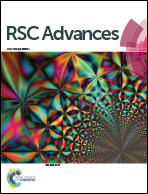The facile preparation of novel magnetic zirconia composites with the aid of carboxymethyl chitosan and their efficient removal of dye
Abstract
Novel composites based on magnetic zirconia was synthesized with the aid of carboxymethyl chitosan (Fe3O4/ZrO2–CMCS) by a facile method. The as-synthesized products were characterized by wide-angle powder X-ray diffraction (XRD), scanning electron microscopy (SEM), Fourier transform infrared spectroscopy (FTIR). The magnetic zirconia carboxymethyl chitosan (Fe3O4/ZrO2–CMCS) composites consisted of particles which show a better regularity and uniform with 200–300 nm in diameter. The as-obtained Fe3O4/ZrO2–CMCS nanocomposites exhibited high adsorption activity and the adsorption capacity for sunset yellow was up to 143.2 mg g−1 without adjusting pH of the solution. Interestingly, after the carboxymethyl chitosan being eliminated by calcining in air, the as-obtained Fe3O4/ZrO2 showed enhanced photocatalytic activity under sunlight irradiation. The degradation rate of rhodamine B as well as sunset yellow was 89% and 84% in 240 min, respectively, due to the addition of the Fe3O4/ZrO2 photocatalyst under sunlight irradiation. Both Fe3O4/ZrO2–CMCS and Fe3O4/ZrO2 can be recycled and reused easily, due to magnetism of iron oxide in the composites. Considering the high adsorption performance of Fe3O4/ZrO2–CMCS and the enhanced photocatalytic activity of Fe3O4/ZrO2 for dye stuff, these two nanocomposites can be applied in treating the waste water contaminated by organic dye stuff.


 Please wait while we load your content...
Please wait while we load your content...